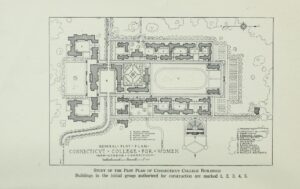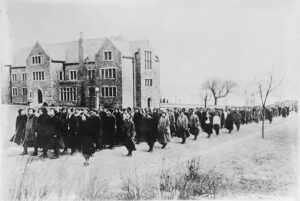By Emily Clark
What started as a group of three stone buildings atop a vast, treeless land in 1911 has become one of the preeminent private institutions for higher learning in the state. At a time when most universities accepted only men, Connecticut College for Women—later Connecticut College—was a state pioneer whose humble beginnings served a meaningful purpose—to provide a liberal arts education for women.
An Opportunity to Educate Women
In the United States, women’s colleges began popping up in the mid-19th century. In Connecticut, however, there were very few institutions that admitted women. At the turn of the 20th century—as the suffrage movement gained momentum and social roles gradually shifted—women increasingly desired and pursued the opportunity for a college education. Though some elite all-male colleges began creating affiliated female colleges, one Connecticut school made a startling announcement in 1909. Wesleyan University, co-ed since 1872, suddenly ceased enrolling women after some of its male alumni felt that coeducation lessened its standing among other elite universities. This decision left no in-state option for Connecticut’s female students to obtain a four-year college education.
Wesleyan alumna Elizabeth C. Wright then formed a committee to consider establishing a women’s college, and it soon identified prospective sites across the state. After some debate, committee members chose a grassy hilltop and former dairy farm overlooking Long Island Sound and the Thames River in New London as a prime and picturesque location.
Financial assistance followed from local businesses, surrounding towns, and the city of New London, which raised $135,000. An endowment of one million dollars from financier Morton F. Plant ensured the school’s development. Chartered in 1911 as Connecticut College for Women, this first all-female college in the state boasted a mission to “educate students to put the liberal arts into action as citizens in a global society.” It aimed to offer the educational caliber of Vassar and Oberlin and invited women with ambition and promise to apply for admission.
The Inaugural Class Takes Their Seats
The board of trustees chose Frederick H. Sykes (who had previously taught English literature at several other universities) as the college’s first president. Under the trustees’ guidance, construction began on the first campus buildings, including the Plant and Blackstone dormitories, New London Hall (which housed academic departments, studios, administrative offices, and a library), and others. The college hired a faculty of 23 men and women—many of whom held doctorate degrees—to teach rigorous courses in 14 majors. By fall 1915, Connecticut College for Women was ready to open their doors to the first incoming class.
One hundred and fifty-one young women arrived on campus on September 27. Many were day students, some commuting from as far away as Fishers Island, New York. Though most students were Connecticut residents, a handful arrived from El Paso, Texas and Mineral, Washington, drawn to a place whose founding some hailed as a turning point in the higher education of women.
“Lofty Towers” Then and Now
During his speech on opening day, President Sykes shared his vision of this new college with students, faculty, administration, and guests who journeyed to Connecticut from universities throughout the northeast. He promised the women’s college would be a “union of old education with the new, ideals of culture and character united with technical training, social direction, and human sympathy” and that he saw “its lofty towers already on the horizon.” Later that evening when the festivities ended, he wrote to a friend: “We are off, and the real adventure has begun!”
That adventure continued throughout the 20th century, weathering two world wars, turbulent decades, and a major social shift which led the college to admit men in 1969. After more than 50 years as an all-women institution, the change to coeducation prompted the school to shorten its name to Connecticut College. Today, it continues to thrive with approximately two thousand co-eds, dozens of buildings, and a reputation of distinction.
Emily Clark is a freelance writer and an English and Journalism teacher at Amity Regional High School in Woodbridge.










